TOXNET HELP TEXT - DART
ContentsSEARCH SCREEN
- Entering a Search Query
- Synonym Searching
- Browse the Index
- Limits
- Databases
- Other NLM Resources/Support Pages
SEARCH RESULTS (DART SPECIAL)
- About Your Search Results
- Save Checked Items
- Sort
- Details
- History
- Download
- Modify Search
- Basic Search
- Browse Index
- TOXNET Home
- Page Navigation
SELECTED RECORD SCREEN (DART SPECIAL)
- About the Selected Record Screen
- Related Records
- Search Results
- Download
- Basic Search
- Browse Index
- Modify Search
- Details
- History
- TOXNET Home
DART SPECIAL AND DART CORE
DART SPECIAL FIELD MNEMONICS
HOW THE SYSTEM SEARCHES FOR AND DISPLAYS RECORDS
ADVANCED SEARCHING FEATURES
RECOMMENDED BROWSERS
SEARCH SCREEN
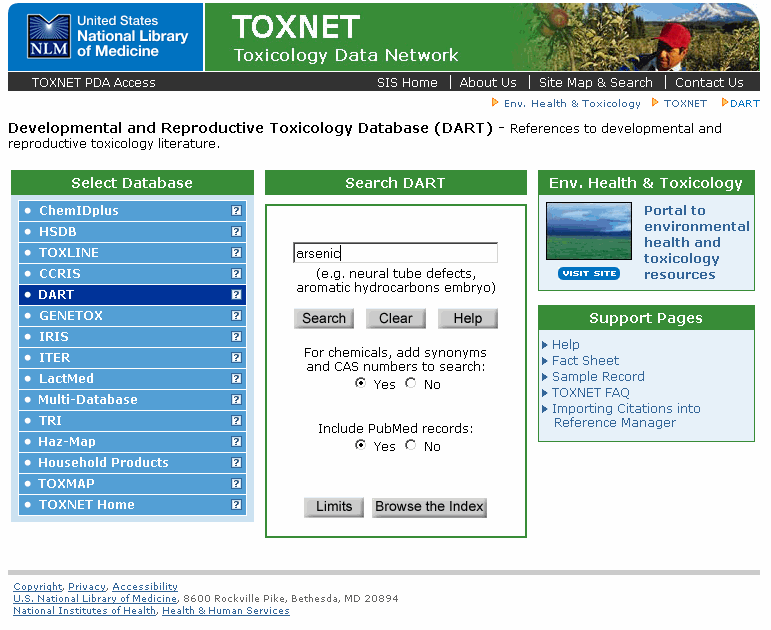
DART consists of two components: DART Special and DART Core. For a description of the two components, please refer to the DART SPECIAL AND DART CORE section of this Help page.
Entering a Search Query
In the query box, enter one or more terms (e.g., arsenic) which describe your search topic. These may be any combination of words, chemical names, and numbers, including Chemical Abstracts Services (CAS) Registry Numbers (RN). Common "stop words" such as "a," "an," "for," "the," and "it," although you may enter them, will not be searched.
Examples of search terms:
- acetone
- vinyl chloride
- 67-64-1
- 75-01-4
- brain
- dna adducts
- skin tumors in mice
- biomarkers
- aflatoxin b1
You have the option of searching the DART Special (default selection) or DART Core component of DART, or both.
The term(s) entered will be searched for in all DART fields.
The search will be initiated when you click the Search button. To erase your search term(s) and start over with a blank query box, click on the Clear button.
Synonym Searching
If your query consists of chemicals, TOXNET will, by default (i.e., the radio button "Yes" is selected), expand your search by adding synonyms and CAS Registry Numbers. Thus, if you enter "perchloroethylene," the system will add the CAS RN 127-18-4 and synonyms such as "tetrachloroethylene" and "tetrachloroethene." You have the option to turn off this feature by selecting the button "No." This will result in a search only for the exact word(s) you entered. In the example above, the system would then look only for the word "perchloroethylene."
For typical queries, it is suggested that you leave the synonym searching feature on ("Yes" button selected) in order to maximize retrieval. On the other hand, if you were searching specifically for a brand name product, say "tylenol," and were interested only in records that mentioned the chemical with that name, you might want to turn off synonym searching ("No" button selected).
Browse the Index
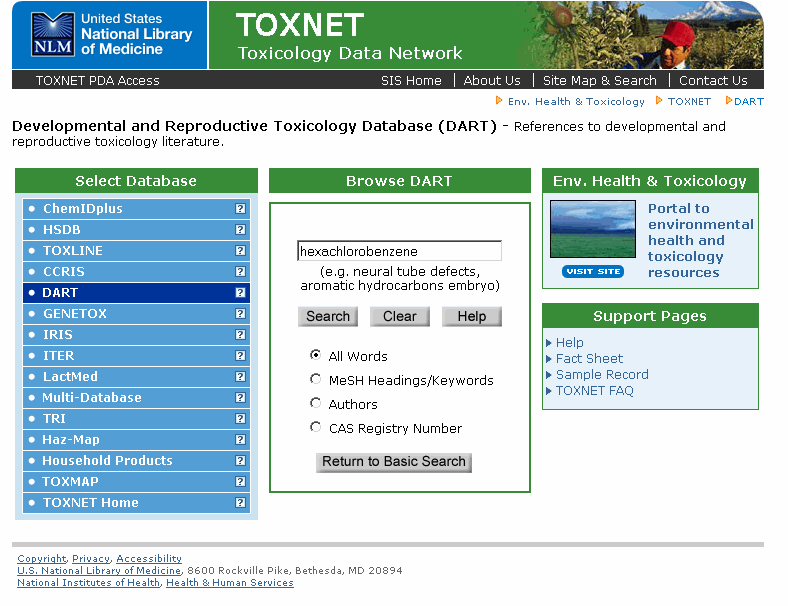
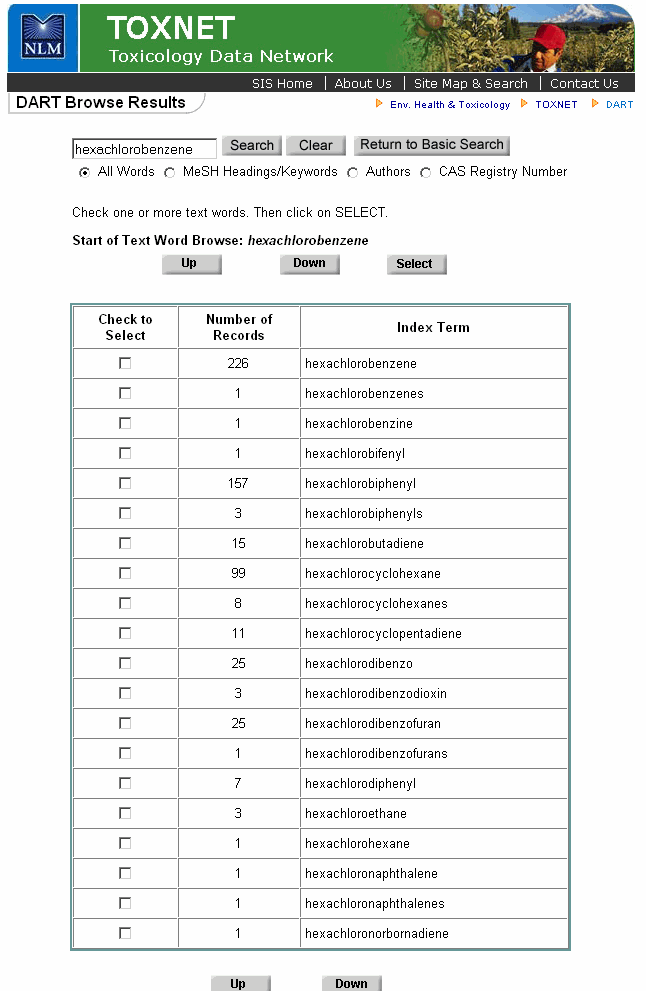
Clicking on the Browse the Index button will display a segment of the DART index, beginning with the term you enter (e.g., hexachlorobenzene), and let you scan the index alphabetically (or numerically) above or below the original display by clicking on the Up or Down button. For each index term, the system displays the number of DART records containing that term. By checking the "Check to Select" box(es) corresponding to the index term(s) of interest and clicking on the Select button, you can search on the selected term(s). You may browse the index to all words, MeSH headings/keywords, authors, or CAS Registry Numbers.
Limits
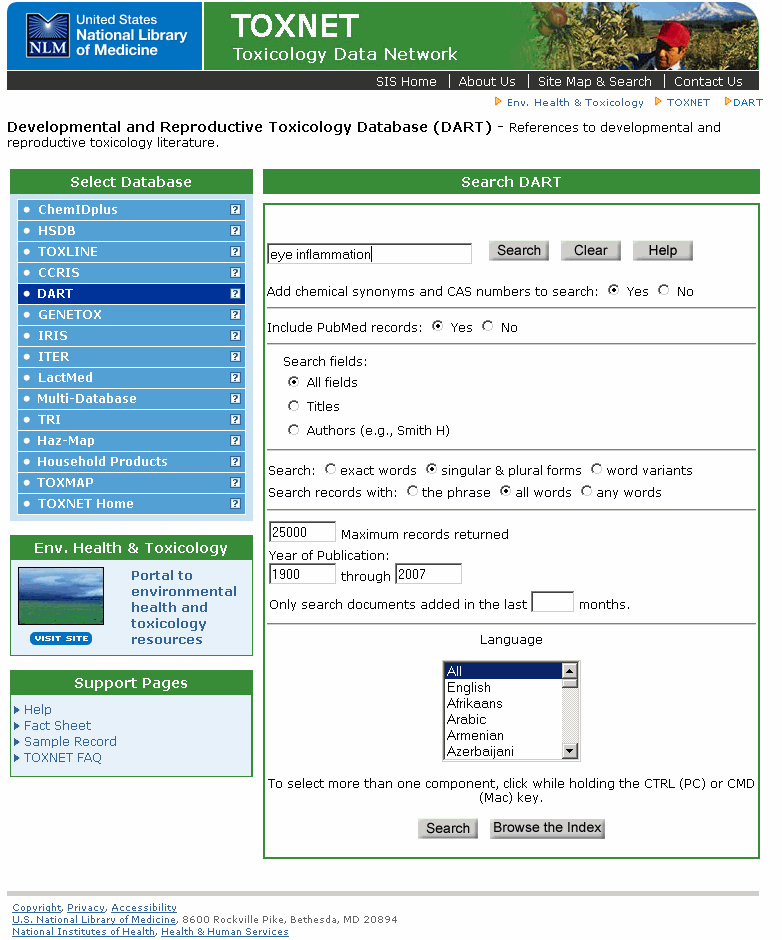
The "Limits" interface boosts search precision over the Basic Search interface by allowing you to specify subfiles and otherwise fine-tune your search. As in a basic search, you would select whether you want to search in DART Special, DART Core, or both simultaneously.
You may search within all fields or limit your search to just the author or title field. The system's default is to search for your term(s) in all DART fields. However, you may prefer to limit your search to a particular field. Authors should be searched as last name followed by a space and either first or first and middle initial (e.g., Honiger J, Pauli LF). Using both first and middle initials will allow for more precise searching, although using just the first initial will offer more leeway in finding articles by those authors who sometimes do and sometimes do not use a middle initial. Searching in the title field can retrieve potentially more relevant articles, since a word in the title typically signals a major focus of the article. An article entitled "Lead Poisoning in Children" is likely of more relevance, if your interest is in lead, than an article entitled "Metal and Pesticide Poisoning in Children," where "lead," mentioned in the abstract, is one of many chemicals discussed. Searching by title will also reduce the size of your retrieval compared to searching all fields.
The DART "Limits" interface also allows you to specify whether you want the words entered to be searched as exact words, singular and plural forms, or word variants and whether, when multiple words are entered, the search should be conducted for all the words, any of the words, or as a phrase.
You may also specify the maximum number of records you would like retrieved, specify a range of publication years, or restrict your search to a specific number of recent months. Finally, you can choose to view articles written only in particular languages.
Databases (The Left Column of the Screen)
Clicking on any of the cells in this column will take you directly to the search screen for the database selected. "Multi-databases" offers simultaneous searching of HSDB, CCRIS, IRIS, and GENE-TOX. The information icon ("i") next to each database provides a brief description of it, with links to a more detailed Fact Sheet and a sample record.
Other NLM Resources, Support Pages (The Right Column of the Screen)
You may also visit additional NLM Web-Based Resources:
Or Support Pages:DIRLINE - Directory of health and scientific organizations.Tox Web Links - Links to additional toxicology Web sites.MEDLINEplus Tox/Env Health - Consumer health information on toxicology and environmental health topics.PubMed - Access to the MEDLINE database of biomedical literature.NLM Gateway - Searches across multiple NLM databases.Locatorplus - NLM's online catalog of books, audiovisuals, and journals.
Help - Detailed documentation, such as what you are reading now, about searching TOXNET.Fact Sheet - Provides an expanded description of DART.Sample Record - A look at a sample DART record.
SEARCH RESULTS
About Your Search Results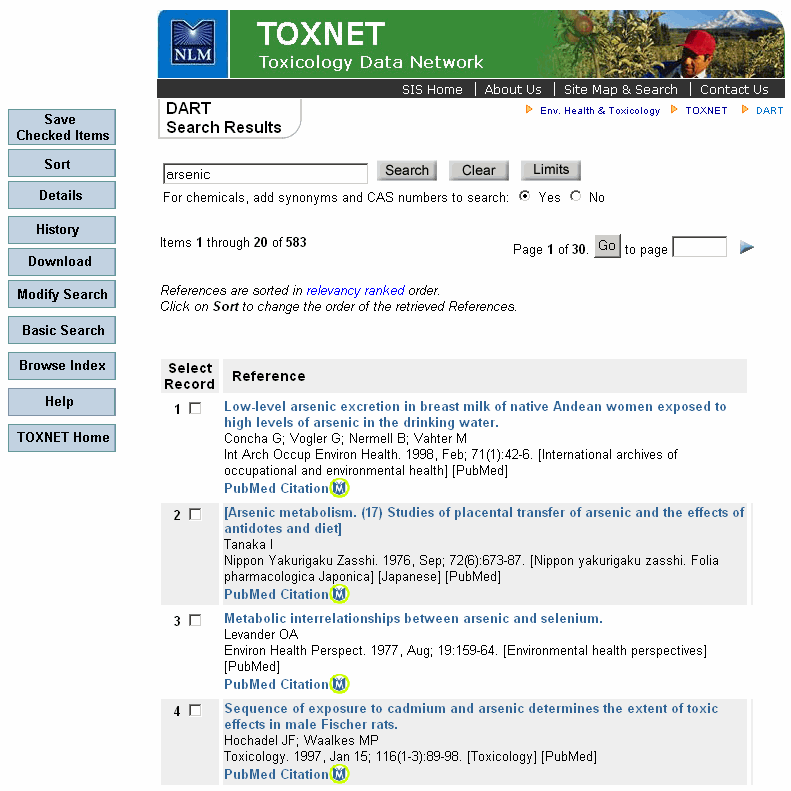
Your initial retrieval is displayed as a list of bibliographic references with the titles highlighted in blue and underlined. The references are displayed according to a Relevancy Ranking algorithm. If you entered more than one term and these terms did not appear together in any of the records retrieved, the system will display those records containing fewer than all of the terms. Clicking directly on any of the items will provide a display of the Selected Record Screen, containing all the data, for that item.
By checking one or more of the numbered boxes to the left of the list of records, you can perform operations, such as downloading, on these selections at a later time.
You can alter your search, if you choose, directly in the query box which reappears on this page with your search terms. Alternately, you can use the Modify Search button, described below.
The vertical series of buttons on the left side of the Search Results page offers a variety of options:
Save Checked Items � This is used to create a subset of your search results. First check the records you want to save, then click on Save Checked Items. The system confirms the number of items you saved and lets you display just these references by clicking on a new button which is added to the sidebar - Display Saved Items.
Sort � Sort all or some of the records alphabetically (in ascending or descending order) by either year of publication, title, author, entry month, or relevance.
Details � Summarizes the strategy used by TOXNET to perform your search. This will include your query terms plus any synonyms or CAS Registry Numbers added by the system.
History � Reviews your search session by itemizing your search statements, numbering them sequentially, and listing the number of records retrieved. Clicking on History allows you to view earlier search result sets or combine these sets provided they are within the same database.
Download � You can download all or some of the records in "brief," "full," "abstract," or "tagged" format.
Modify Search � Return to the Basic Search screen with your search strategy retained. You can make changes or perform a new search at this point.
Basic Search - Return to the Basic Search screen with the query box cleared. You can now enter a new search.
Browse Index � This feature displays a segment of the DART index, beginning with the term you enter, and lets you scan the index alphabetically (or numerically) above or below the original display by clicking on the Up or Down button. For each index term, the system displays the number of DART records containing that term. By checking the "Check to Select" box(es) corresponding to the index term(s) of interest and clicking on the Select button, you can search on the selected term(s). You may browse the index to all words, MeSH headings/keywords, authors, or CAS Registry Numbers.
TOXNET Home � Return to the TOXNET Home Page.
Page Navigation - The top and bottom of each Search Results page displays the total number of pages, the current page number, the total number of items, and the items displayed on the current page. You can navigate through multi-page search results by specifying a page number and clicking on the "Go" button or by using the blue arrows to go to the following or preceding page(s). These navigation features appear at the top and bottom of each Search Results page.
Note - The display of search results for DART Core will differ somewhat. "Help" documentation is available on PubMed.
SELECTED RECORD SCREEN (DART SPECIAL)
About the Selected Record Screen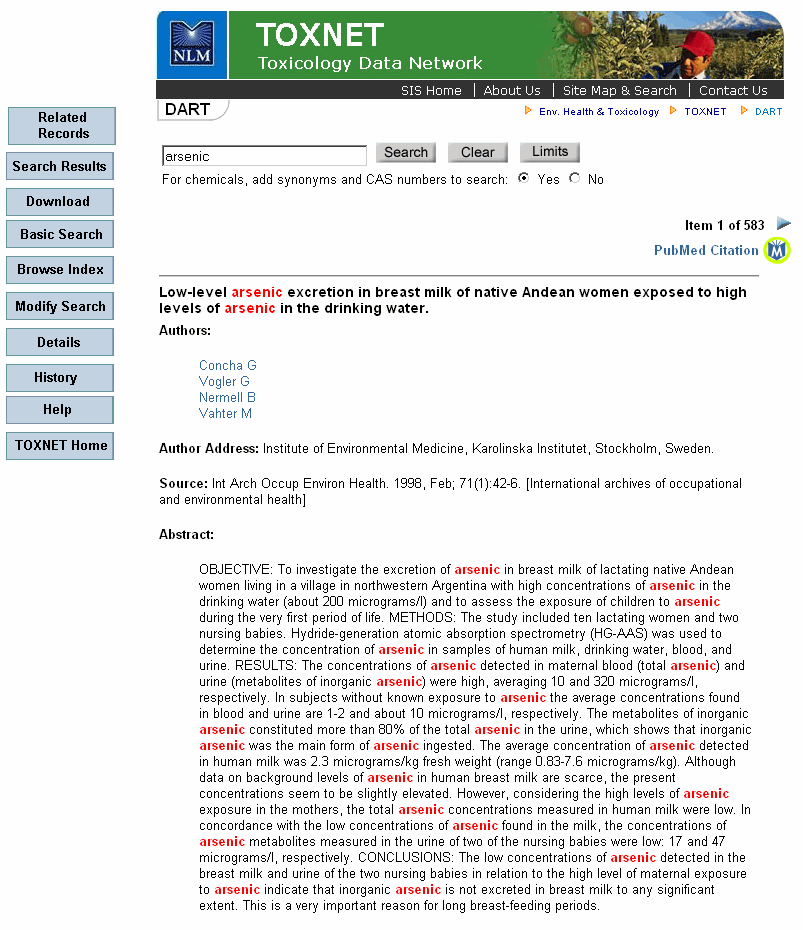
This screen displays the complete record for whichever item you selected on the Results Screen. Your search terms are highlighted in red. Authors, MeSH Headings, Keywords, and CAS Registry Numbers are highlighted in blue, underlined, and hot-linked. Thus, by clicking on an author, you can find other articles by that author, and by clicking on a keyword, you can find other articles indexed with that keyword. Other information appearing includes the article language, the month it was entered into the system, the year of publication, and a secondary source ID - a unique identifying number for the record.
You can alter your search, if you choose, directly in the query box which reappears on this page with your search terms. Alternately, you can use the Modify Search button, described below.
On the left side of the screen is a column with the following buttons:
Related Records - Searches for articles similar in subject matter to the one being displayed.
Search Results - Return to the Search Results display.
Download - The following three options are available for downloading: full, abstract, and tagged.
Basic Search - Return to the Basic Search screen with the query box cleared so that you can enter a new search.
Browse Index - This feature displays a segment of the DART index, beginning with the term you enter, and lets you scan the index alphabetically (or numerically) above or below the original display by clicking on the Up or Down button. For each index term, the system displays the number of DART records containing that term. By checking the "Check to Select" box(es) corresponding to the index term(s) of interest and clicking on the Select button, you can search on the selected terms. You may browse the index to all words, MeSH headings/keywords, authors, or CAS Registry Numbers.
Modify Search - Return to the Basic Search screen with your search strategy retained. You can make changes or perform a new search at this point.
Details - Displays a summary of the strategy you specified for your search and synonyms added by the system.
History - Reviews your search session by itemizing your search statements, numbering them sequentially, and listing the number of records retrieved. Clicking on History allows you to view earlier search result sets or combine these sets provided they are within the same database.
TOXNET Home - Return to the TOXNET Home Page.
DART SPECIAL AND DART CORE
The DART database, like TOXLINE, now has two components: DART Core and DART Special. DART Core links to a subset of MEDLINE/PubMed references related to developmental and reproductive toxicology and covers a wider range of topics than previously included. The profile of terms used to create the search strategy run against MEDLINE to create DART Core may be viewed on PubMed. DART Special links to references not included in MEDLINE/PubMed, such as meeting abstracts, books, technical reports, and journals not indexed for MEDLINE.
Enter a search strategy in the DART search box and select either DART Core, DART Special, or Both. Selecting Both will return two sets of results in separate windows: 1) journal literature from MEDLINE/PubMed and 2) additional references from DART Special. Selecting DART Core will only retrieve the core journal literature in MEDLINE/PubMed and selecting DART Special will only retrieve citations to meeting abstracts, books, technical reports, and journals not indexed for MEDLINE.
HOW THE SYSTEM SEARCHES FOR AND DISPLAYS RECORDS
TOXNET searches for your terms, in singular and plural form, throughout all records unless you specify particular fields or restrict the form of your terms via the "Limits" interface. The system will automatically look for synonyms and CAS Registry Numbers of chemicals unless you choose to disable this feature.
If you search for multiple terms and there are records containing all the terms, the system will display only these. If none of the records retrieved contains all the terms, the system will display records that contain at least one of the terms, with an indication of which of the terms was found.
Relevancy ranking attempts to determine which documents are most pertinent to the search, and to place the most relevant documents first in the list of returned documents. The ranking is based upon the number of individual search terms occurring in a document, the number of times each search term occurs in a document, its rarity within the database, and the nearness of search terms to each other. Documents containing combinations of search words tend to be ranked higher than documents having isolated occurrences of the words.
DART SPECIAL FIELD MNEMONICS
| Field Names | Mnemonics |
|---|---|
| Title | [ti] |
| Abstract | [ab] |
| MeSH Heading | [mh] |
| Keyword | [kw] |
ADVANCED SEARCHING FEATURES
Users seeking a finer degree of precision in retrieval than available through either TOXNET's standard Basic Search screen or Limits option searching may want to consider formulating searches through the use of field qualifiers and/or Boolean logic.
Users seeking a finer degree of precision in retrieval than available through TOXNET's standard relevancy ranking methodology may want to consider formulating searches through the use of field qualifiers and/or Boolean logic.
Field Qualifying is a method whereby you can specify the particular field in which you want your term searched. In DART, if you wanted to limit your search of the word "kidney" to those references where the word appears in the title, you would enter "kidney [ti]." Be advised that when you qualify a search by data field mnemonic, you are instructing the TOXNET system to search precisely the field you have specified. If the search term does not appear in the qualified field, an error message stating that "No records were found for the search" will be generated. A list of database fields and corresponding mnemonics for DART may be found at DART Special Field Mnemonics.
Boolean Searching utilizes the logical operators OR, AND, NOT. It is a means of limiting your search of two or more terms to criteria you specify, and is often used in conjunction with field qualifying, described above. Logical operators must appear in upper case. Searches containing combinations of these operators are processed with ANDs taking precedence, followed by NOTs, and then followed by ORs. This default precedence may be overridden with the use of parentheses, which may also be nested (i.e., parentheses within parentheses).
- OR - Often, in bibliographic databases such as DART, it is helpful to limit a search to terms found only in article titles. A search for the words "liver" or "kidney" in the title field would take the form "liver [ti] OR kidney [ti]."
- AND - This operator is used to search for the co-occurrence of two or more search terms. To search DART for article titles containing both the words "heart" and "murmur," you would enter "heart [ti] AND murmur [ti]."
- NOT - This operator allows you to exclude terms from your search. Searching in DART's title field for chemical effects on blood, but not blood pressure, might be accomplished by entering "blood [ti] NOT pressure [ti]."
- Parentheses - To search DART for toxic effects on brain or cerebellum in rats or mice, you would enter "(rats OR mice) AND (brain OR cerebellum)."
Truncation - The asterisk (*) may be freely used as a truncation symbol standing for any number of characters. Searching in DART for spin* [ti] will retrieve records with words such as spine, spinal, spino, and spinally in the title. Truncation may be used with or without field qualifying/Boolean searching.
Phrase Searching - In phrase searching, quotation marks ("�") are included as part of the search strategy and are used to search for two or more terms exactly the way they are entered. In DART, you might want to search for articles on the effects of pesticides on bone marrow as follows: pesticides AND "bone marrow". Phrase searching may be used with or without field qualifying/Boolean searching.
RECOMMENDED BROWSERS
TOXNET is best viewed with Internet Explorer 4.0 or Netscape 4.0 or higher versions, for either PC or Mac.